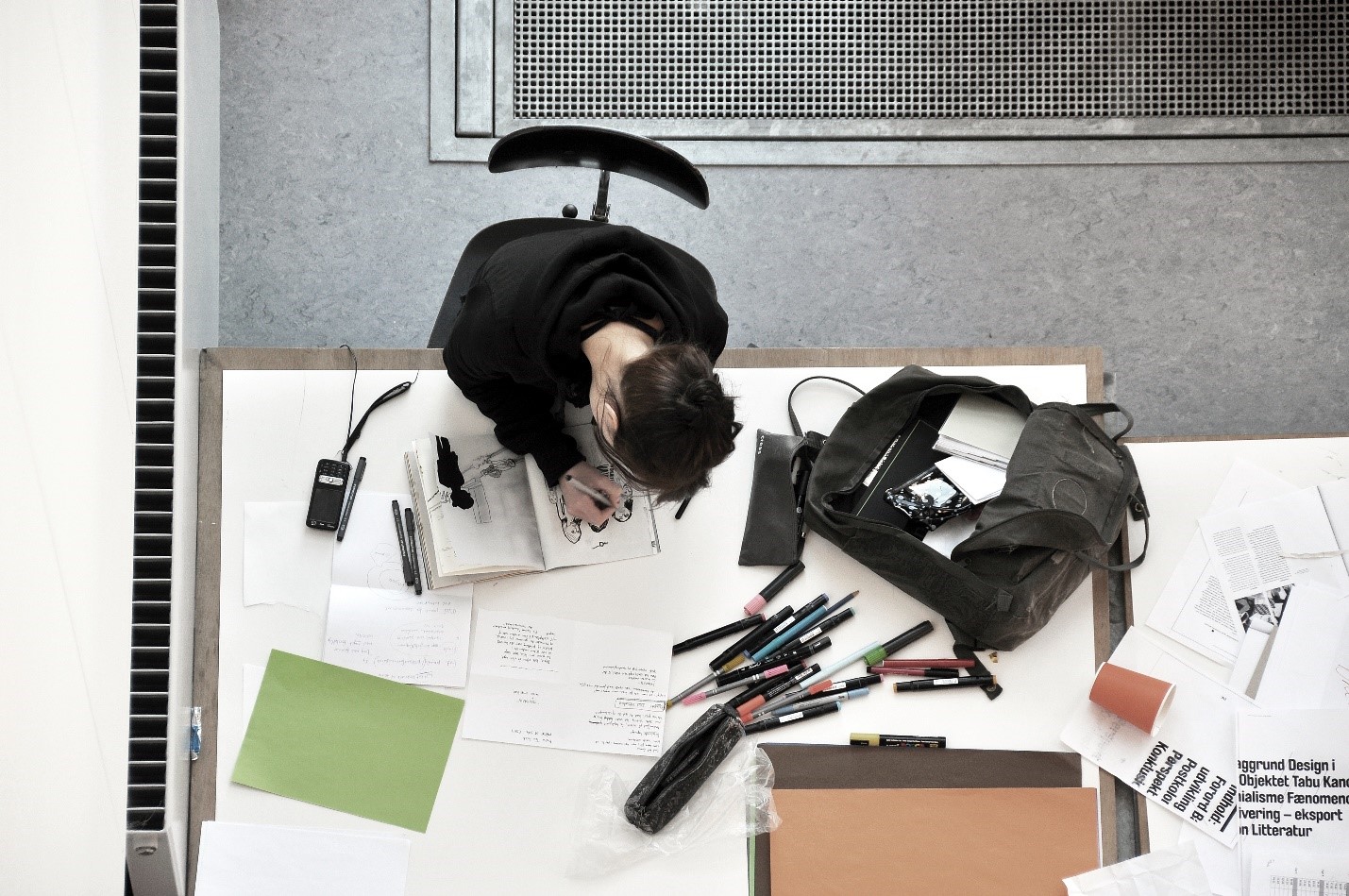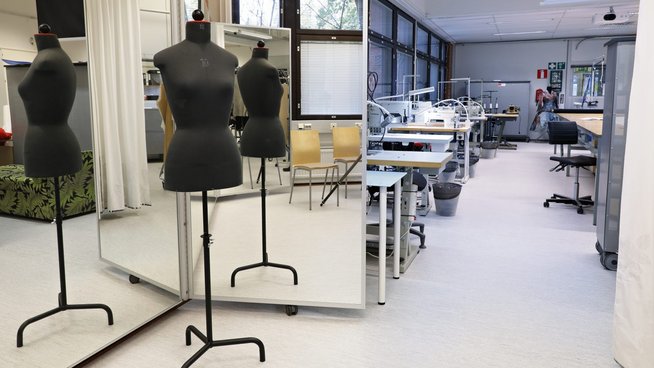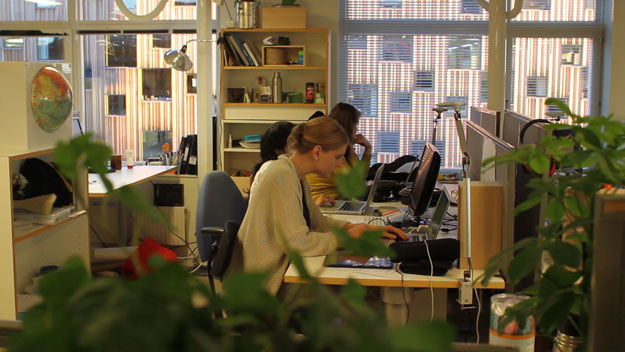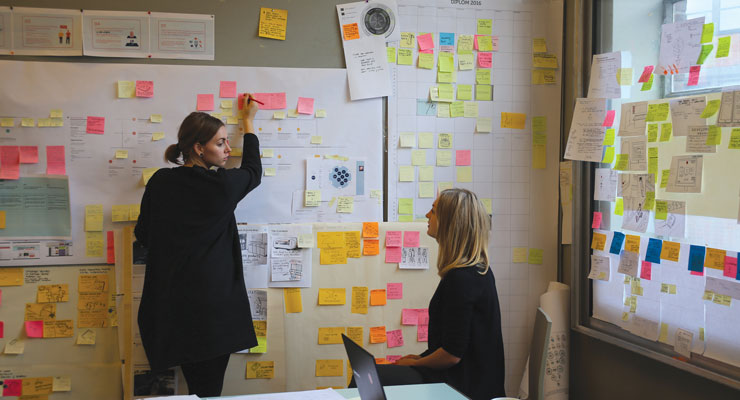Studio-Based Learning in the Nordics
Studio-Based Learning (SBL) is an educational tradition with a student-centered approach. The practice originates in Northern Europe, where Nordic arts and design programs have a long tradition of using studio spaces for teaching. The physical space is considered a powerful factor in facilitating learning and accomplishing instructional goals, and it remains widespread at higher education institutions. SBL goes beyond the passive learning styles typically afforded by the traditional university classroom or lecture hall. For example, SBL allows students to be involved in iterative hands-on experimentation followed by reflection.

Higher Education in the Nordics
Higher education (HE) in the Nordic countries is traditionally a central element of each country’s welfare system with distinctive features, such as, the absence of tuition fees and reliance on egalitarian principles – and largely funded by the state. Despite national differences across the Nordic countries, Nordic HE can be said to be characterized by a student-centered teaching style, focusing on problem-solving and critical thinking, where students are educated to challenge the status quo as opposed to merely retaining knowledge. This teaching style can be traced back to the early 19th century with the introduction of the Humboldtian model of higher learning, which has had a profound influence on the development of university pedagogy in Europe generally as well as the Nordic countries.
Studio-Based Learning
The pedagogy of Studio-Based Learning (SBL) is an educational tradition with a distinctive student-centered approach, which emerged in a Northern European context. The tradition of SBL in an educational context is over a century old. The use of studio spaces for educational purposes can be traced back to the mid-17th century with institutions like École Des Beaux-Arts in France and the early 20th century Bauhaus School in Germany. These institutions gave rise to the present notions of ‘the studio’ in arts and design as a physical place for unfolding creative potential and designing products and services. The cornerstone of learning at the École des Beaux-Arts system was problem-based and relied on learning-by-doing and especially ‘critique sessions’ where work-in-progress designs and sketches were assessed by a master-like teacher or supervisor. This style of teaching has roots back in the notion of the master-apprentice relationship found in the arts and craft professions during the Middle Ages where the apprentice was exposed to the work of a highly experienced 'master' (such as a designer, artist, or craftsman) and worked and learned respective skills by working alongside the master in a studio. Fast-forward to the 21st century, the studio space is still at the core of teaching and learning on arts and design programs.

The arrangement of a physical space is a powerful factor in facilitating learning and accomplishing instructional goals: Costume and Workshop Studio at Alto Studios in Alto University, Finland. Photo: Courtesy of Aalto Studios/Studio Olli-Pekka Orpo.
The studio environment: usage across disciplines
Nordic arts and design programs have a long tradition of using studio spaces for teaching following the idea that the arrangement of a physical space is a powerful factor in facilitating learning and accomplishing instructional goals. SBL is widespread at many of the Nordic arts and design institutions which include: The Royal Danish Academy of Fine Arts (Denmark), VIA University College (Denmark), Konstfack University of Arts, Crafts and Design (Sweden), Umeå Institute of Design (Sweden), Oslo National Academy of the Arts (Norway), the Oslo School of Architecture and Design (Norway), Iceland University of the Arts (Iceland), Oulu School of Architecture, University of Oulu (Finland), and the School of Arts, Design and Architecture at Alto University (Finland). These HE institutions teach studio-based courses and offer studio spaces for their students to use at all hours. Unlike libraries with spaces for students to study or laboratories where students can perform experiments, the studio spaces afford crafting and play, where accidents and associations lead to inspiration and creative insight.
More recently, design-inspired studio spaces have appeared at business schools, including Copenhagen Business School in Denmark, where the SBL pedagogy has been brought into management and leadership classes, amongst other programs. This development of business studios is connected to the broader educational task of the business school, namely the design-thinking approach to problem-solving where the creative and imaginative side of design and arts join up with business and science to create user-centered and innovative solutions. The business studio emphazises an inquiry process with fundamentally different principles compared to more controlled environments leading to creative problem-solving and innovation, which is one of the reasons for business schools to embrace the studio setting for teaching and learning.

The typical studio space - as used within architecture, arts, and design – often consists of a dedicated space with a desk for each student to use at all hours throughout their studies. Student Studios at Umeå Institute of Design, Umeå University, Sweden. Photo: Courtesy of Umeå University.
The typical studio space - as used within architecture, arts, and design – often consists of a dedicated space with a desk for each student to use at all hours throughout their studies. The studio space can include elements such as an atelier, a computer room, or an open space with flexible furniture and sharable screens, where students work on artistic and open-ended design projects with a mentor-like teacher, who encourages a creative and experimental application of the curriculum. Having studio spaces available for students to use individually or in groups does however require a large amount of spatial facilities and is more costly than traditional lecture halls. The model of SBL-teaching used may also be more expensive compared to lecture-based or online teaching with fewer contact hours with each student. However, compared to new computer laboratories and equipment, the studio environment can in fact be provided at relatively low cost.
Studio structures and habits of mind
SBL has particular features that enable a different way of learning that goes beyond the passive learning styles typically afforded by the traditional university classroom or lecture hall. As an example, the pedagogical possibilities of SBL allows teachers to engage students in iterative hands-on experimentation followed by reflection with supervisors and fellow students. The structure of SBL can take on many different formats. Studies in the use of studios within different levels of arts and design education show that the structure of studio pedagogy can be described as a variation of four basic elements:
- Lecture (or demonstration): teachers (or practitioners) deliver information, set assignments, or in other ways convey information, which is useful for students to work in class or at home.
- Students-at-work: students solve a given assignment using specific tools and materials.
- Critique sessions: a format for discussion and reflection, where students display work-in-progress and receive feedback from teachers or specialists.
- Exhibition: students display their work in either a physical or virtual space.
Furthermore, other research has suggested that SBL has the ability to influence the students in new ways by fostering a wider range of thinking dispositions - also referred to as 'habits of mind' – than more traditional forms of education. These different habits of mind or dispositions are related and often occur at the same time when working in the studio, but they are also used in other academic areas and daily life. The habits of mind that have been identified by researchers are: observing, envisioning, reflecting, expressing, exploring, engaging and persisting, developing, and understanding professional domains. Some habits of mind are more often utilized within arts and design programs, whereas others, such as observing and envisioning, are more common within business or science programs. These habits of mind result from orchestration of the studio pedagogy, the social environment, and the physical set-up such as furniture, tools, light, and sounds.

Students are able to, for example, design, plan, and organize part of a service to improve quality and interaction between user, interface, and provider. Here you see service design students at The Institute of Design, Oslo School of Architecture and Design, Norway. Photo: Courtesy of the Oslo School of Architecture and Design.
21st-century skills: creativity, collaboration and entrepreneurship
Entrepreneurship ranks high on the agenda of HE institutions in the 21st century and so does the employment of HE graduates. A 2018 report by the World Economic Forum provides a list with the most important skills for employment which includes complex problem-solving, critical thinking, creativity, people management, and coordination with others.
Learning to become an entrepreneur and starting up a business requires students at HE institutions to gain hands-on experience with practices associated with entrepreneurial work such as uncertainty, drastic changes, reflection, empathy, and creativity. The working practices trained in SBL resemble that of entrepreneurial work in dynamic environments and this therefore suggests that SBL may positively affect students’ entrepreneurial skills. Recently, it has been suggested that SBL might evoke an entrepreneurial mindset in students – a way of thinking that enables them to rapidly analyze, act, and mobilize under uncertain or ambiguous conditions. The studio space offers a dynamic task environment, which may help foster an entrepreneurial way of thinking through practices and habits of mind, such as, the reframing of the problem or task, engagement with various stakeholders, and revisiting and re-thinking ideas and solutions after receiving critique or feedback from supervisors during the process. Finally, in a Danish context, it is noteworthy that design graduates who mostly receive studio-based learning turn to entrepreneurial ventures about three times more often than the average HE graduate.
In the studio environment, what often takes place is that the students are given a task, often set by a professional company or client posing a challenge or problem. Students then work in teams to solve this task, involving potential end-users and customers in the process. The process may also involve meetings with stakeholders and clients along with pitches and co-creation sessions. These type of processes may help teach the students skills such as people management and coordination, which are needed to create innovative solutions and succeed in the future. Graduate students possessing entrepreneurial skills and entrepreneurial competencies may be better equipped to think innovatively and tackle global challenges, which may lead to future growth, job creation, and prosperity.
Further reading:
- D. Barry & S. Meisiek, ‘Discovering the Business Studio’. Journal of Management Education, 39, 1, (2015) pp. 153–175.
- L. Hetland, E. Winner, S. Veenema, & K.M. Sheridan, Studio Thinking 2: The real benefits of visual arts education (Second Ed.). (New York: Teachers College Press, Columbia University, 2013).
- U. Isopahkala-Bouret, M. Börjesson, D. Beach, N. Haltia, J.T. Jónasson, A. Jauhiainen, A., A. Vabø, Education Inquiry Access and stratification in Nordic higher education. A review of cross-cutting research themes and issues. Education Inquiry, 9,1 (2018), pp. 142–154.